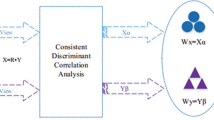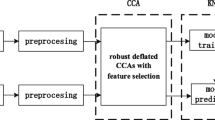Abstract
Canonical correlation analysis (CCA) is one of the most well-known methods to extract features from multi-view data and has attracted much attention in recent years. However, classical CCA is unsupervised and does not take discriminant information into account. In this paper, we add discriminant information into CCA by using random cross-view correlations between within-class samples and propose a new method for multi-view dimensionality reduction called canonical random correlation analysis (RCA). In RCA, two approaches for randomly generating cross-view correlation samples are developed on the basis of bootstrap technique. Furthermore, kernel RCA (KRCA) is proposed to extract nonlinear correlations between different views. Experiments on several multi-view data sets show the effectiveness of the proposed methods.
Similar content being viewed by others
Explore related subjects
Discover the latest articles and news from researchers in related subjects, suggested using machine learning.References
Duda R O, Hart P E, Stork D G, Pattern Classification. 2nd ed. New York: Wiley-Interscience, 2000.
Yarowsky D. Unsupervised word sense disambiguation rivaling supervised methods. In: Proceedings of the 33rd Annual Meeting on Association for Computational Lingustics. 1995, 189–196
Xia T, Tao D, Mei T, Zhang Y. Multiview spectral embedding. IEEE Transactions on Systems, Man, and Cybernetics, Part B: Cybernetics, 2010, 40(6): 1438–1446
Zheng H, Wang M, Li Z. Audio-visual speaker identification with multi-view distance metric learning. In: Proceedings of 17th IEEE International Conference on Image Processing. 2010, 4561–4564
Wang M, Li H, Tao D, Lu K, Wu X. Multimodal graph-based reranking for Web image search. IEEE Transactions on Image Processing, 2012, 21(11): 4649–4661
Yu J, Wang M, Tao D. Semisupervised multiview distance metric learning for cartoon synthesis. IEEE Transactions on Image Processing, 2012, 21(11): 4636–4648
Long B, Philip SY, Zhang Z. A general model for multiple view unsupervised learning. In: Proceedings of the SIAM International Conference on Data Mining. 2008, 822–833
Han Y, Wu F, Tao D, Zhuang Y, Jiang J. Sparse unsupervised dimensionality reduction for multiple view data. IEEE Transactions on Circuits and Systems for Video Technology. 2012, 22(10): 1485–1496
Xie B, Mu Y, Tao D, Huang K. m-SNE: multiview stochastic neighbor embedding. IEEE Transactions on Systems, Man, and Cybernetics, Part B: Cybernetics, 2011, 41(4): 1088–1096
Hotelling H. Relation between two sets of variates. Biometrica, 1936, 28: 321–377
Diethe T, Hardoon D R, Shawe-Taylor J. Multiview fisher discriminant analysis. In: Proceedings of NIPS Workshop on Learning from Multiple Sources. 2008
Akaho S. A kernel method for canonical correlation analysis. In: Proceedings of the International Meeting of the Psychometric Society. 2001
Vía J, Santamaría I, Pérez J. A learning algorithm for adaptive canonical correlation analysis of several data sets. Neural Networks. 2007, 20(1): 139–152
Hardoon D R, Szedmak S, Shawe-Taylor J. Canonical correlation analysis: an overview with application to learning methods. Neural Computation, 2004, 16(12): 2639–2664
Yang C, Wang L, Feng J. On feature extraction via kernels. IEEE Transactions on Systems, Man, and Cybernetics, Part B: Cybernetics, 2008, 38(2): 553–557
Sun T, Chen S. Locality preserving CCA with applications to data visualization and pose estimation. Image and Vision Computing, 2007, 25(5): 531–543
Blaschko M B, Jacquelyn J A, Bartels A, Lampert C H, Gretton A. Semi-supervised kernel canonical correlation analysis with application to human fMRI. Pattern Recognition Letters, 2011, 32(11): 1572–1583
Blaschko M B, Lampert C H, Gretton A. Semi-supervised laplacian regularization of kernel canonical correlation analysis. Lecture Notes in Computer Science, 2008, 5211: 133–145
Golugula A, Lee G, Master S R, Feldman M D, Tomaszewski J E, Speicher D W, Madabhushi A. Supervised regularized canonical correlation analysis: integrating histologic and proteomic measurements for predicting biochemical recurrence following prostate surgery. BMC Bioinformatics, 2011, 12(1): 483
Thum A, Mönchgesang S, Westphal L, Lübken T, Rosahl S, Neumann S, Posch S. Supervised Penalized Canonical Correlation Analysis. 2014, arXiv preprint arXiv:1405.1534
Jing X Y, Hu R M, Zhu Y P, Wu S S, Liang C, Yang J Y. Intra-view and inter-view supervised correlation analysis for multi-view feature learning. In: Proceedings of the 28th AAAI Conference on Artificial Intelligence. 2014
Jing X, Sun J, Yao Y, Sui Z. Supervised and unsupervised face recognition method base on 3CCA. In: Proceedings of International Conference on Automatic Control and Artificial Intelligence. 2012, 2009–2012
Guo S, Ruan Q, Wang Z, Liu S. Facial expression recognition using spectral supervised canonical correlation analysis. Journal of Information Science and Engineering, 2013, 29(5): 907–924
Shelton J A. Semi-supervised subspace learning and application to human functional magnetic brain resonance imaging data. Dissertation for the Doctoral Degree. Oxford: University of Oxford, 2010
Sun T, Chen S, Yang J, Shi P. A novel method of combined feature extraction for recognition. In: Proceedings of the 8th IEEE International Conference on Data Mining. 2008, 1043–1048
Majumdar A, Ward R. Robust classifiers for data reduced via random projections. IEEE Transactions on Systems, Man, and Cybernetics, Part B: Cybernetics, 2010, 40(5): 1359–1371
Wegelin J A. A survey of partial least squares (PLS) methods, with emphasis on the two-block case. Department of Statistics, University of Washington, Technical Report. 2000, 371
Bourke P. Cross correlation. Auto Correlation–2D Pattern Identification, 1996
Theodoridis S, Koutroumbas K. Pattern Recognition. 3rd ed. New York: Academic Press, 2006
Sun Q, Zeng S, Liu Y, Heng P, Xia D. A new method of feature fusion and its application in image recognition. Journal of Pattern Recognition, 2005, 38(12): 2437–2448
Melzer T, Reiter M, Bischof H. Appearance models based on kernel canonical correlation analysis. Journal of Pattern Recognition, 2003, 36(9): 1961–1971
Shawe-Taylor J, Williams C K I, Cristianini N, Kandola J S. On the eigenspectrum of the gram matrix and the generalization error of kernel-PCA. IEEE Transactions on Information Theory, 2005, 51(7): 2510–2522
Bach F R, Jordan MI. Kernel independent component analysis. Journal of Machine Learning Research, 2002, 3: 1–48
Turk M, Pentland A. Eigenfaces for recognition. Journal of Cognitive Neuro Science, 1991, 3(1): 71–86
Belhumeur P N, Hespanha J P, Kriegman D J. Eigenfaces vs. fisherfaces: recognition using class-specific linear projection. IEEE Transactions on Pattern Analysis and Machine Intelligence, 1997, 19(7): 711–720
He X, Cai D, Niyogi P. Lplacian score for feature selection. Advances in Neural Information Processing Systems. 2005, 18: 507–514
Cai D, He X, Hu Y, Han J, Huang T. Learning a spatially smooth subspace for face recognition. In: Proceedings of IEEE Conference on Computer Vision and Pattern Recognition. 2007, 1–7
Ahonen T, Hadid A, Pietikainen M. Face recognition with local binary patterns. In: Proceedings of the 8th European Conference on Computer Vision. 2004, 469–481
Zhang J, Zhang D. A novel ensemble construction method for multiview data using random cross-view correlation between within-class examples. Pattern Recognition, 2011, 44(6): 1162–1171
Author information
Authors and Affiliations
Corresponding authors
Additional information
Yanyan Zhang received the MS degree in computer science and application from Nanjing University of Aeronautics and Astronautics, China in 2010. Now she is a teaching assistant in PLA University of Science and Technology, China. Her current research interests include face recognition and sparse learning.
Jianchun Zhang received the MS degree in computer science and application from Nanjing University of Aeronautics and Astronautics, China in 2010. His research interests include pattern recognition and image processing.
Zhisong Pan received the BS degree in computer science and MS degree in computer science and application from PLA Information Engineering University, China, in 1991 and 1994 respectively, and the PhD degree in Department of Computer Science and Engineering, Nanjing University of Aeronautics and Astronautics, China in 2003. From July 2006 to the present, he has led several key projects of intelligent data processing for the network management. His current research interests mainly include pattern recognition, machine learning and neural networks.
Daoqiang Zhang received the BS and PhD degrees in computer science from Nanjing University of Aeronautics and Astronautics (NUAA), China in 1999 and 2004, respectively. He is currently a professor in the Department of Computer Science and Engineering of NUAA. His research interests include machine learning, pattern recognition, data mining, and image processing. In these areas, he has published over 40 technical papers in refereed international journals or conference proceedings. He was nominated for the National Excellent Doctoral Dissertation Award of China in 2006, and won the best paper award at the 9th Pacific Rim International Conference on Artificial Intelligence (PRICAI’06). He has served as a program committee member for several international and native conferences. He is also a member of Chinese Association of Artificial Intelligence (CAAI) Machine Learning Society.
Electronic supplementary material
Rights and permissions
About this article
Cite this article
Zhang, Y., Zhang, J., Pan, Z. et al. Multi-view dimensionality reduction via canonical random correlation analysis. Front. Comput. Sci. 10, 856–869 (2016). https://doi.org/10.1007/s11704-015-4538-7
Received:
Accepted:
Published:
Issue Date:
DOI: https://doi.org/10.1007/s11704-015-4538-7




